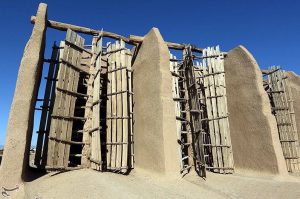
Ancient windmills in Nashtifan village. Photo: Mohammad Hossein Taghi (CC by 4.0)
What are we going to need when we hit space and start settling other planets? Energy.
With no promise of fossil fuels on planets which may not have millions of years of active biosphere before our arrival, we will need mature energy technologies available universally on planets suitable for habitation.
(1) Solar Power
(2) Wind Power
(3) Water Power
(4) Gravity Power
Anywhere we choose to permanently settle will have these energies available. No guarantee for radioactive minerals needed for fusion and fission takes those two politically fraught items off the plate. Not every planet has a tamed magnetic-sphere (see the posting about Uranus).
To survive humans need gravity, heat (solar), and water. Wind is a by-product of the other three requirements. A planet large enough to have a water system and gravity for humans is going to have uneven heating, therefore wind.

From eSchoolToday “What is Wind Energy”
Humans have been using these energies for millennia, and yet the technologies, likely because of their simplicity and ubiquity, have never been fully developed.
Today humanity is testing out dozens of different windmill designs, mostly based on sail and lift technology. We might want to go old school though.

Ancient windmills in Nashtifan village. Photo: Mohammad Hossein Taghi (CC by 4.0)
Vertical windmills work on drag. Unfortunately drag is less efficient in transferring energy than lift, but some of the benefits may outweigh this downside. For example where horizontal windmills have their mechanisms toward the top, where the rotation center is located, vertical windmills rotation center is at the bottom and any mechanisms needing repair are within easy reach. Transferring energy from the top of a horizontal windmill requires a system to move the energy, often pulleys, which means more things to break.
Nowhere is the ease of maintenance and repair more obvious than the grinding windmills of Nashtifan village, which have been in use for over 1,000 years. To protect the village from the constant winds, a massive 65-foot wall was built. On top of the wall, since they were up there anyway, they put windmills. To make them even more efficient, they added some additional walls to direct the airflow into the windmills. A little rope, some planks, and grinding grain ceased being a constant chore.
Vertical windmills also don’t need any wind-sensing and orientation mechanisms built-in like the lift-based windmills. This reduces efficiency but, again, saves on maintenance. (See the wikipedia entry on “Vertical axis wind turbines” for more details.)
Considering the tradeoffs and developing both types of windmills (and other wind technology like the Vortex bladeless windmill) is part of creating a mature technology. Sometimes easy maintenance is primary and other times most bang for the immediate buck; having options available is key to using a technology to its fullest potential.
Who would think a thousand year old technology may be our go-to energy when settling other planets?